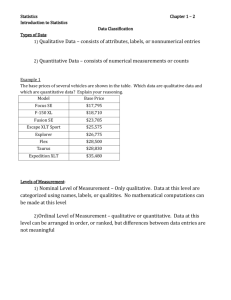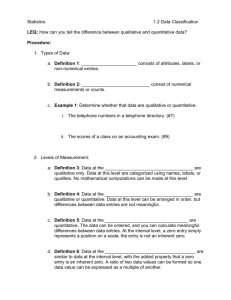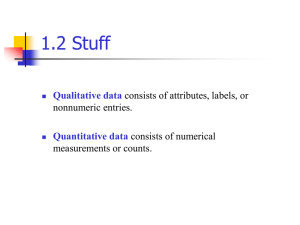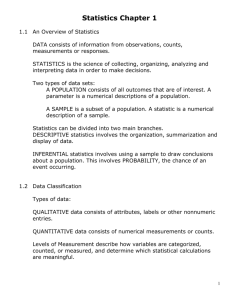Ch1-Sec1.2
advertisement
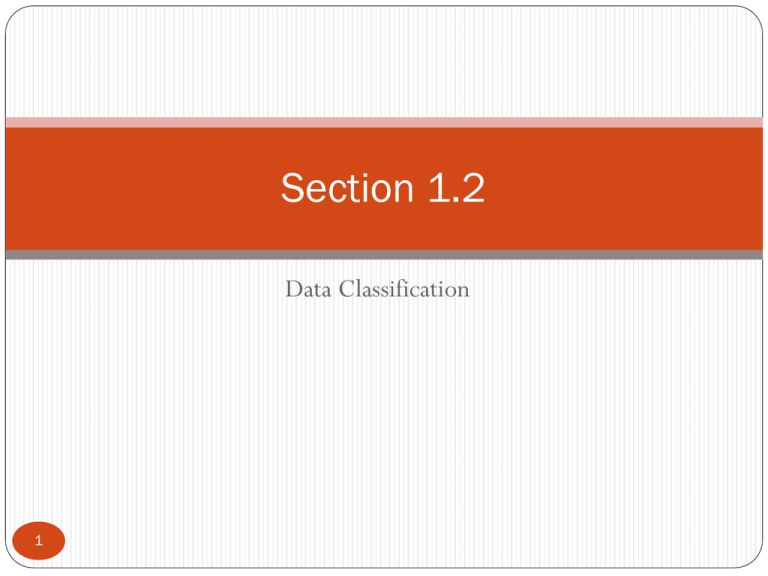
Section 1.2 Data Classification 1 Section 1.2 Objectives Distinguish between qualitative data and quantitative data Classify data with respect to the four levels of measurement 22 Types of Data Qualitative Data Consists of attributes, labels, or nonnumerical entries. Can be separated into different categories that are distinguished by some nonnumeric characteristics Major Place of birth Eye color Example: the genders of college graduates 33 Types of Data Quantitative data Numerical measurements or counts. Numbers representing counts or measurements. Age Weight of a letter Temperature Example: the incomes of college graduates 44 Example: Classifying Data by Type The base prices of several vehicles are shown in the table. Which data are qualitative data and which are quantitative data? (Source Ford Motor Company) 55 Solution: Classifying Data by Type Qualitative Data (Names of vehicle models are nonnumerical entries) 66 Quantitative Data (Base prices of vehicles models are numerical entries) Question: Distinguishing Between Qualitative and Quantitative Variables Determine whether the following variables are qualitative or quantitative. (a) Type of wood used to build a kitchen table. (b) Number of yards Tiger Woods hits his drives. (c) Number of times your Internet service goes down in the next 30 days. 77 Levels of Measurement Nominal level of measurement Qualitative data only Categorized using names, labels, or qualities No mathematical computations can be made Example: survey responses yes, no, undecided Ordinal level of measurement • Qualitative or quantitative data • Data can be arranged in order • Differences between data entries is not meaningful Example: course grades A, B, C, D, or F 88 Example: Classifying Data by Level Two data sets are shown. Which data set consists of data at the nominal level? Which data set consists of data at the ordinal level? (Source: Nielsen Media Research) 99 Solution: Classifying Data by Level Ordinal level (lists the rank of five TV programs. Data can be ordered. Difference between ranks is not meaningful.) 110 0 Nominal level (lists the call letters of each network affiliate. Call letters are names of network affiliates.) Levels of Measurement Interval level of measurement Quantitative data Data can ordered Differences between data entries is meaningful Zero represents a position on a scale (not an inherent zero – zero does not imply “none”) Example: years 1000, 2000, 1776, and 1492 111 1 Levels of Measurement Ratio level of measurement Similar to interval level Zero entry is an inherent zero (implies “none”) A ratio of two data values can be formed One data value can be expressed as a multiple of another Example: prices of college textbooks 112 2 Example: Classifying Data by Level Two data sets are shown. Which data set consists of data at the interval level? Which data set consists of data at the ratio level? (Source: Major League Baseball) 113 3 Solution: Classifying Data by Level Interval level (Quantitative data. Can find a difference between two dates, but a ratio does not make sense.) 114 4 Ratio level (Can find differences and write ratios.) Summary of Four Levels of Measurement Put data in categories Arrange data in order Subtract data values Determine if one data value is a multiple of another Nominal Yes No No No Ordinal Yes Yes No No Interval Yes Yes Yes No Ratio Yes Yes Yes Yes Level of Measurement 115 5 Levels of Measurement Nominal - categories only Ordinal - categories with some order Interval - differences but no natural starting point Ratio - differences and a natural starting point 116 6 Section 1.2 Summary Distinguished between qualitative data and quantitative data Classified data with respect to the four levels of measurement 117 7
